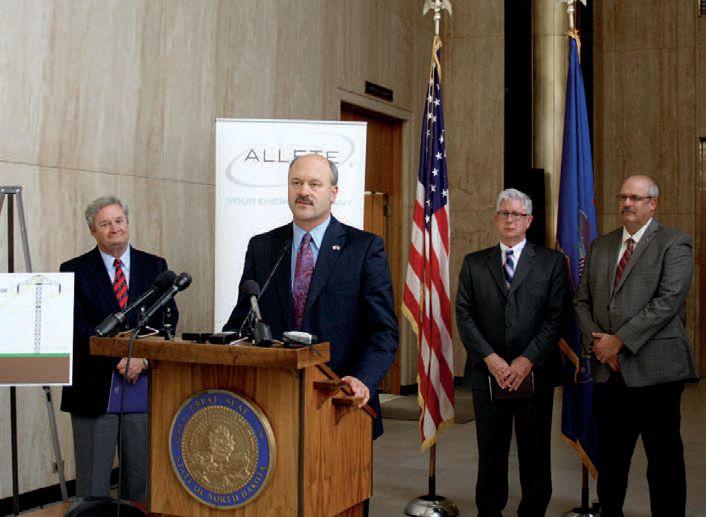
2 minute read
Bakken energy corridor plan
Gov. Dalrymple, Allete announce vision to establish 500-mile pipeline system alongside existing transmission system
BY KRIS BEVILL
Natural gas flaring has become an increasingly critical issue in the Bakken but extensive pipeline networks need to be installed before gas can be captured and moved to locations for processing and usage. Pipelines also continue to be in demand to move oil and wastewater out of the region. None of it can be accomplished without land-use agreements to locate infrastructure, but after years of receiving continuous requests to access land for various uses landowners are tiring of the process and landowner fatigue has become a concern throughout the region as well.
Duluth, Minn.-based energy company Allete believes it has devised a plan that could dually ease landowner fatigue and deliver energy and other products to and from the Bakken. The company currently owns a 465-mile-long transmission line which delivers electricity from the Milton R. Young power plant near Center, N.D., and the Bison Wind Energy Center near New Salem, N.D., to Duluth and is current- ly working to expand the line about 60 miles west to a location in the Bakken region. The company believes that an energy transportation corridor, consisting of multiple pipelines, could be developed alongside the transmission line path, utilizing the existing right of way and minimizing land use.
Al Hodnik, president, chairman and CEO of Allete, unveiled the company’s energy corridor vision during a news conference held Sept. 25 at the North Dakota State Capitol in Bismarck. He said the company believes a single, wide belt of right of way would ease landowner fatigue and help solve a number of pressing energy concerns within the state and region. Pipelines to move natural gas and oil could reduce flaring and truck and train traffic in the Bakken. From Duluth’s port, where the energy corridor would end, the products could easily be transported to large markets on the East Coast, he said.
Additionally, he noted the potential for carbon dioxide from North Dakota’s coal-fired power plants to be sent along the energy corridor to the Bakken for enhanced oil recovery, although he admitted there is currently no demand for that extraction method at this time. Other potential uses for the energy corridor could include wastewater transport from the Bakken to fertilizer plants soon to be built on the eastern side of North Dakota. Drinking water could also be moved from western North Dakota to urban populations such as Fargo. The energy corridor also presents the potential for more wind power to be produced, stored and transported, he said.
The proposal has drawn the support of Gov. Jack Dalrymple who, along with representatives of the state’s Empower Commission, joined Allete officials for the announcement. “It’s very important that we reduce flaring and expand our takeaway capacity for oil and natural gas,” Dalrymple said. “We need to move significantly more natural gas than we are now.” He said Allete’s proposal offers the opportunity for the state to accomplish that and he will encourage other companies to consider participating in the project.
It is not yet known how much the energy corridor project would cost or how it would be paid for, although one possibility is that Allete would carry out the project and lease space in the corridor for others to use. The project is admittedly years from fruition, but the company has already begun studying projects that could produce usage agreements, according to Eric Norberg, president of Allete Clean Energy. “We look forward to working with project developers and government officials to implement this vision,” he said. “We have an opportunity to pursue investments that will help solve some current issues and lay the groundwork for more efficient movement of energy products, water and wastewater in the future.” PB










